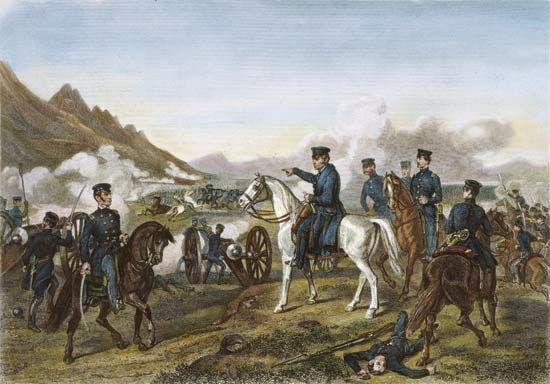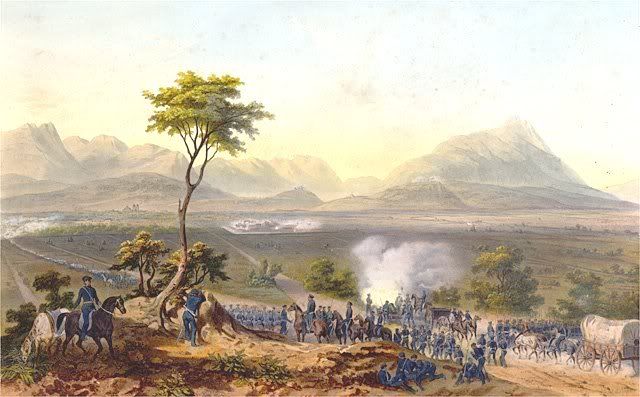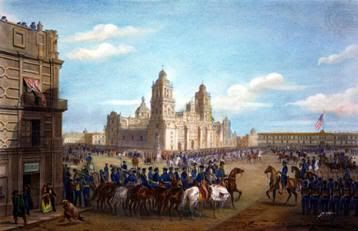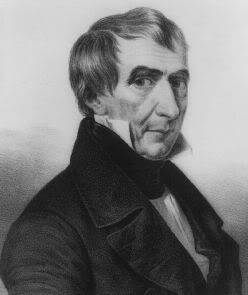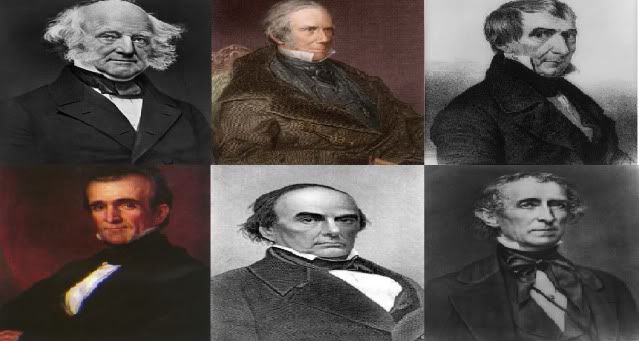Henry Clay
Episode One, Part III
Number Eight: Henry Clay
Party: Whig
60 Years-old, from Kentucky
The Henry Clay Presidency
With the end of the Second Mexican-Texan War, better known as the First Mexican-American War back in the United States, and the Seminole Wars in Florida Henry Clay was now at the height of his popularity. Although both the Senate and the House was controlled by the Democrats, a handful of the Democratic Senators and Representatives were considered Whig-Democrats [1] as they usually voted with the Whigs over the national Democratic Party.
The American success against Mexico didn’t go unheard over in Europe. The British Empire, as well as Spain who had ambitions of reclaiming her colonial empire, were starting to get weary of American power on the North American continent, primarily England who saw the rising American power as a threat to the sovereignty of the Dominion of Canada, the empire’s most important dominion state outside of British India. In Madrid, Spain was reeling back from the independence of her South American colonies in the 1820’s and were having internal problems of her own. Despite of this, the Spanish Kingdom was gaining power and wealth at a rate she hadn’t seen since the Age of Discovery and certainly had ambitions in Mexico once again; especially after the crushing Mexican defeat and loss of nearly half her military at the hands of the United States.
President Henry Clay, realizing the potential problems and not wanting war with England and Canada, the closest of any of the European powers to the United States, and the fact the Democrats would more than likely label him as a National War Hawk rather than a man with the best intentions to govern the country sent Secretary of State Daniel Webster of Massachusetts and Vice-President Hugh Lawson White overseas to London to try and convince the British Parliament that the United States had the best intentions as the year of 1839 was heading into her summer months. For Vice-President White, he would no longer be overseeing the construction of the Baltimore-Charleston Railroad which was currently making headway into North Carolina after a year and a half of construction.
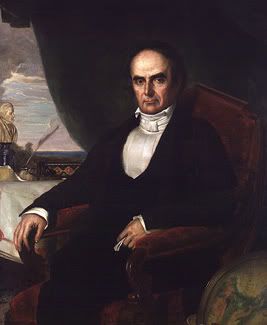
Secretary of State Daniel Webster, the former New England Whig Presidential candidate would become a powerful ally to the Henry Clay Presidency. As he and Vice-President White went over to London, it would be Webster not White who was more outspoken in trying to improve the worrying relations between the two nations.
Slavery and Presidential Limitations
President Clay resumed his push for Slavery Acts to limit the overall expansion of slavery into new western territories. Although a major Whig base was situated in the South, many of the Southern Dixies [2] supported Willie Magnum and Martin van Buren, where the west and north supported Henry Clay; despite of this, President Clay silently sent the ideas into Congress. It was well known in Washington of Clay’s anti-slavery feelings as he was a founding member of the American Colonization Society [3], and he was trying to wield more power for the society as President of the United States.
Outside of being a leading member of the ACS [4], President Clay was a staunch fighter for limiting the power of the Federal Government he thought the Democrats were trying to increase over both Congress and the people of the United States. His Presidential-Limiting Act was sent up to Congress in late June, 1839 which would ultimately restrict Executive Presidential Powers that were installed by John Quincy Adams and later by Andrew Jackson during their combined 12 years in office.
The new session of the 26th Congress benefited the Whig Party in contrast to the 25th Congress. Since the time President Clay took the Presidency, the 25th Congress broke down: 35 Democratic Senators (Senate Majority) against 17 Whig Senators (Senate Minority), and 129 Democratic Representatives (House Majority) against 100 Whigs (House Minority) and 13 Nullifiers and Anti-Masonic representatives. The 26th Congress saw the Whigs pick up 5 seats in the Senate to bring their total up to 22, while the Democrats had a net loss of 5 to bring their total down to 30. In the House the Whigs picked up 9 seats to bring their total to 109 while the Democrats lost 4 seats to go down to 125. The remaining seats went to 6 Anti-Masonic members, and 2 Conservative-Virginian members, all of which would more than likely back the Whigs in the House. It didn’t help the Democrats that Speaker of the House Robert Hunter was a former Whig himself, and like Speaker Polk from the 25th Congress, he held some strong Whig feelings over some Democratic feelings.
The vote on the Act however hit some steam from Senate as William R. King, the President pro tempore of the Senate attacked the Act stating that Henry Clay is trying to return the country to the old Articles of Confederation [5] which was a complete failure which led to the ratification of the United States Constitution and Bill of Rights. President Clay fought back saying that he was just trying to limit the powers of the President as that’s what the Founding Fathers fought to install during and after the War for Independence. Senator King fired back saying that a weak President is even worse than a powerful President as a President who couldn’t do anything serves no purpose. When the House voted on the Act the votes broke down to this:
119 For, 123 Against. Without the House passing the Act, it didn’t need to come to the Senate, rather it returned to President Clay for revision or ultimate destruction. When September arrived, Vice President White and Secretary Webster returned from England with good news, they had managed to not only convince the British they had no intentions on Canada, but they managed to improve relations between the two countries more than expected. This was good news for the President whose defeat in trying to pass the Limiting Act was now overran by the news that he was able to achieve great diplomatic success with the English.
Senator William R. King, a strong member of the Democratic Party and main voice against President Clay’s ambition to further limit the Executive Powers of the President. Some speculate that if he hadn’t taken a strong stand in defense of the Democratic Party and Agenda, the Act would have passed in the House and had come to an extremely close vote in the Senate.
Mangum Tariff
In addition to his other pushes, President Henry Clay pressed for protective tariffs to help 'protect' the economy economy from foreign competition and harm. In the Senate, the Whig South Carolinian recently elected Senate Minority Leader came up with a protective tariff that wouldn't harm the Southern agricultural society and industry, but boost the Northern, principally New England heavy industries. The tariff called for increased prices on British-Canadian and British imports of heavy woods, to be made into furniture, and selected British manufactured goods, therefor, not all British goods suffered the tariff, thereby, keeping England as a top-consumer of cotton and tobacco based products. After all, King Cotton was the breadbasket of the Southern economy. The Bill easily passed the Senate and House and went into effect by the middle of 1839.
Rising Pressures
As the year of 1839 passed into the new year of 1840 problems were emerging for the Clay Administration. The economy of the United States began to sputter down to earth and started as economic depression hit the country. The Democrats were quick to blame the President for the problems saying that the war was to blame for the downturn of the American economy. The problems also hit the Vice-President even harder, a major supporter of passing another railway act despite the Baltimore-Charleston RR was not yet completed, the Baltimore-Charleston RR began to feel the wrath of the economic downturn as workers were being paid less and began to question and demand more for the work they putting into the project as it was making its way into South Carolina.
With 1840 being an election year, President Clay attempted to reassure the people who had achieved so much in 3 years in office: the victory against Mexico, the expansion of territory in the west, the reorganization of the Wisconsin Territory into Wisconsin and Iowa, the near completion of the Baltimore-Charleston Railroad, the improving transportation system and the improving relations between the United States. However, another stone struck the President on April 10 when Vice-President White died in South Carolina overseeing the final moments of the Baltimore-Charleston Railroad as it was only 100 miles from Charleston. The Democrats where also unified behind Martin van Buren who promised a “Return to the prosperity of the Jackson era.”
President Clay was somewhat distraught over the death of his close friend Hugh Lawson White, and was now on the look for a new VP candidate. He came to choose Secretary Daniel Webster. Although Clay was the incumbent, he started to fear William Henry Harrison once again. With many Whigs started to be unsure of the President as the economy continued to fall, they banded together behind William Henry Harrison and John Tyler with the campaign song of “Tip and Ty,” better known as “Tippecanoe and Tyler too [6].” Certainly the election of 1840 was going to be interesting as Clay was going to have to fight against Harrison-Tyler for the Whig ticket, as well as a resurgent Democratic Party.
William Henry Harrison was gaining ground as the Whig Party began to flock to him to be their savior instead of Henry Clay. President Clay was still confident that his impressive record and highly popular for the most of his Presidency would win the Whig ticket just as he did in 1836.
[1] Democrats who held Whig-like ideas and sympathies and were usually voting against the Democratic Party on national issues.
[2] Southern Dixies or Dixies was a common nickname for Americans living in the Southern United States.
[3] The American Colonization Society was founded by three Virginian men, most notably John Randolph. The Society was responsible for the establishment of Liberia in West Africa as well as many Anti-Slavery movements in the early part of the United States of America. It was the main group that would send freed Slaves back to Liberia and formally disbanded in 1964.
[4] An acronym for the American Colonization Society
[5] The first form of American government where the States had total control and the Federal Government really had no power, not even able to level taxes. The problems spilled out in New England where farmers rebelled and was put down by State Militia while the Federal Government sat and could do nothing. Its lack of a strong enough federal government led the founding fathers to write the Constitution in 1787.
[6] Tippecanoe and Tyler too was a famous song that promoted William Henry Harrison and John Tyler in the historical election of 1840 against Martin van Buren. Tippecanoe being the Battle where WH Harrison defeated the Tecumseh’s Confederacy of Native Americans and became an overnight hero and celebrity.




